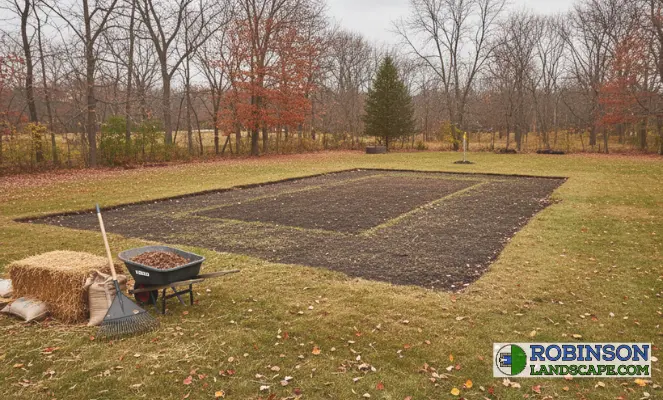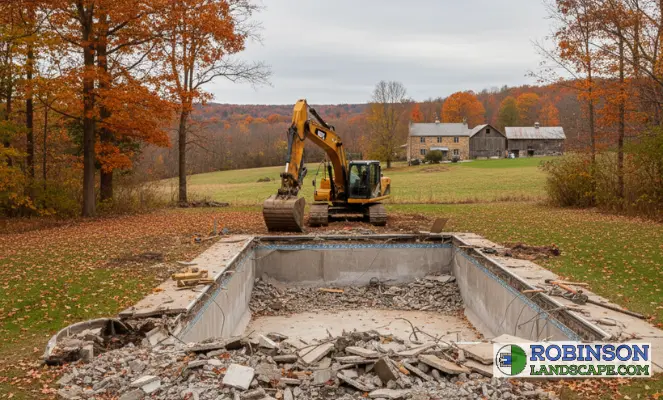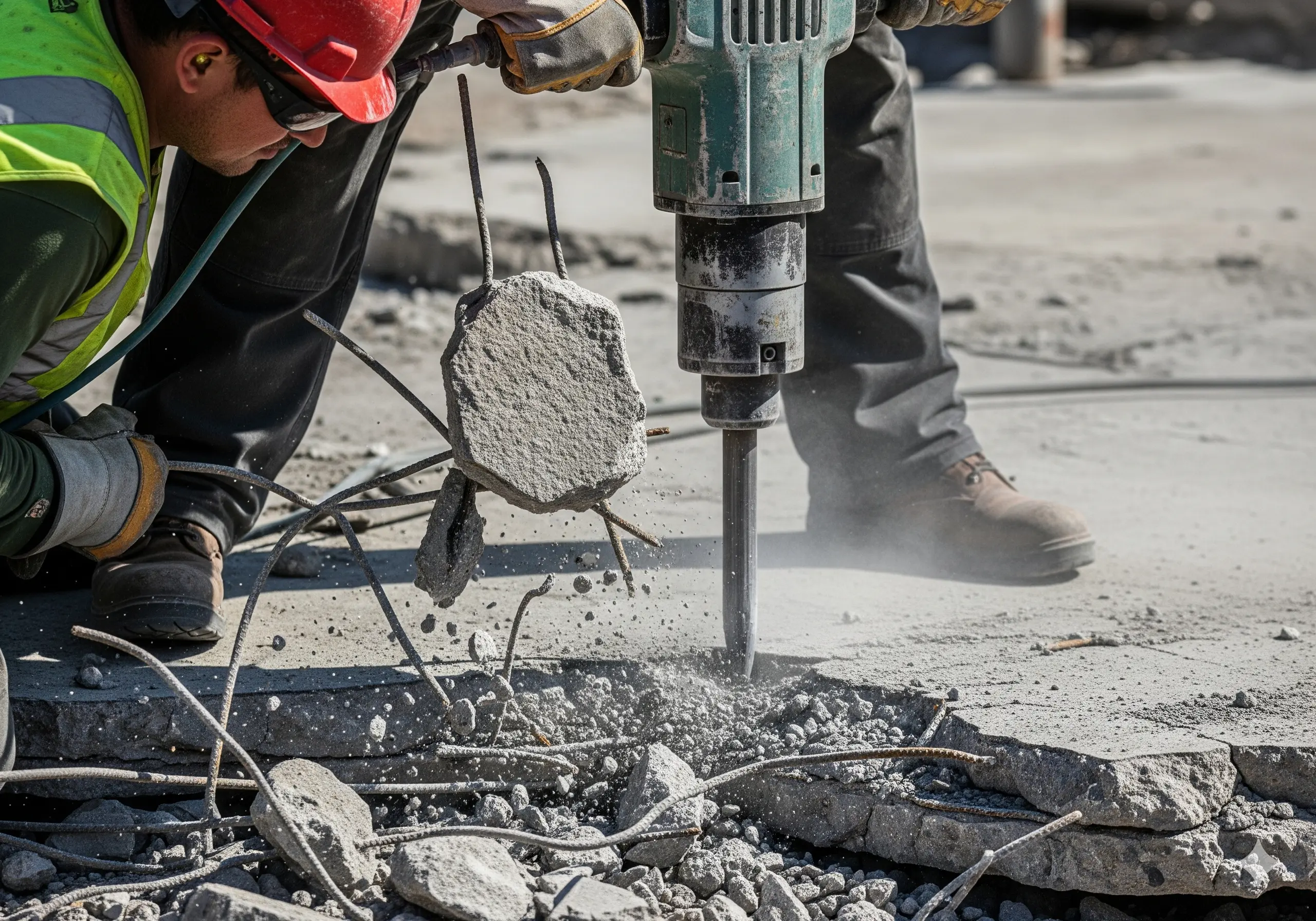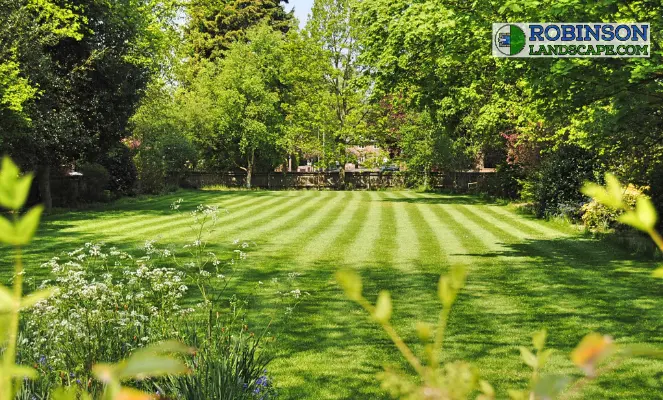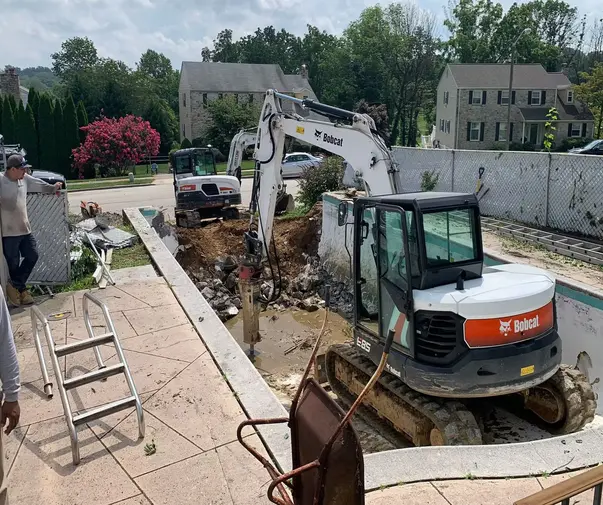Preparing your yard for winter after pool removal requires strategic timing and specific restoration techniques to ensure successful spring growth and prevent erosion during Southeastern Pennsylvania’s harsh winter months. Robinson Landscape, serving Bucks County and Montgomery County since 2000, emphasizes that proper winterization following pool removal protects your investment while establishing optimal conditions for landscape transformation. The critical window between pool removal completion and first frost determines long-term success of your restored yard, with November being the final opportunity for essential preparation steps. Tim Robinson, owner and founder of Robinson Landscape LLC with 24+ years of pool removal expertise, guides homeowners through winterization processes that prevent settling, promote drainage, and protect new grass seedlings through Pennsylvania’s freeze-thaw cycles.
Table of Contents
- What Is Post-Pool Removal Winter Preparation?
- Essential Steps for Winterizing Your Restored Pool Area
- Soil Stabilization and Erosion Prevention
- Protecting New Grass and Seedlings Through Winter
- Drainage Management for Former Pool Sites
- Winter Maintenance Schedule
- Local Considerations for Pennsylvania Residents
- FAQs About Winter Yard Preparation After Pool Removal
- Expert Tips from Tim Robinson
What Is Post-Pool Removal Winter Preparation?
Post-pool removal winter preparation encompasses specialized techniques protecting newly filled and graded areas from harsh winter conditions while establishing foundations for spring landscape success throughout Southeastern Pennsylvania. Robinson Landscape’s comprehensive winterization process addresses unique challenges facing former pool sites during their first winter after removal.
Winter preparation after pool removal focuses on three critical areas: soil stability, drainage management, and vegetation protection that work together preventing damage during Pennsylvania’s severe winter weather. The process begins immediately after pool removal completion, with timing being crucial for properties in Bucks County communities like Doylestown, Newtown Township, and Buckingham where early freezes can arrive by late November.
Newly filled pool areas require special attention because settling continues through winter months, potentially creating depressions that collect water and ice. Robinson Landscape applies specialized compaction techniques and strategic material selection ensuring uniform settling that maintains proper grades throughout freeze-thaw cycles. This attention to detail prevents spring surprises like sunken areas or drainage problems that plague improperly winterized pool removal sites.
The transformation from pool to lawn involves establishing delicate root systems that need protection during their first winter. Unlike established lawns, newly seeded areas over former pools lack mature root networks providing natural erosion resistance. Tim Robinson’s experience shows that proper winter preparation increases spring grass establishment success rates by 75% compared to unprotected sites throughout Montgomery County and surrounding areas.
Professional winterization also addresses potential soil chemistry changes from pool removal, as residual chemicals and altered pH levels affect plant establishment. Robinson Landscape tests soil conditions and applies appropriate amendments before winter, allowing freeze-thaw cycles to naturally distribute treatments throughout the root zone. This preparation ensures optimal growing conditions when spring arrives at properties from Perkasie to Lansdale.
Essential Steps for Winterizing Your Restored Pool Area
Winterizing your yard after pool removal requires systematic approaches addressing multiple vulnerability factors before harsh weather arrives in Southeastern Pennsylvania. Robinson Landscape follows proven protocols developed through 24+ years of experience ensuring successful winter transitions for restored pool sites.
Final grading and compaction represent the foundation of successful winterization, with proper surface slopes directing water away from structures and preventing pooling in former pool locations. Robinson Landscape performs final grade checks in November, making adjustments before ground freezing locks in imperfections. Properties along Route 611 and near Neshaminy Creek particularly benefit from precise grading due to clay soil conditions.
Mulching strategic areas provides insulation and erosion control during winter months, with organic materials breaking down to enrich soil for spring growth. A 2-3 inch layer of straw mulch over newly seeded areas protects germinating grass while allowing moisture penetration. Tim Robinson recommends avoiding heavy bark mulches that can smother new grass, instead choosing lighter materials appropriate for Bucks County’s climate conditions.
Installing temporary erosion barriers prevents soil washout during winter storms and spring snowmelt common throughout communities like Warminster, Horsham, and Abington. Robinson Landscape positions silt fences and erosion control blankets based on slope analysis and drainage patterns specific to each property. These measures prove especially important for properties with elevation changes where former pools occupied sloped areas.
Applying winter fertilizer specifically formulated for new grass establishment provides slow-release nutrients supporting root development during dormancy. The timing of this application, typically in early November before ground freezing, allows nutrients to penetrate soil while avoiding excessive top growth vulnerable to winter damage. Robinson Landscape uses Pennsylvania-specific formulations accounting for local soil conditions and grass varieties suited to Southeastern Pennsylvania.
Marking restored areas prevents accidental damage from snow removal equipment during winter months. Clear identification of former pool boundaries helps homeowners and snow removal services avoid driving heavy equipment over settling fill materials. This simple step prevents costly spring repairs and maintains proper compaction achieved during pool removal completion.
Soil Stabilization and Erosion Prevention
Soil stabilization in former pool areas requires specialized techniques preventing erosion and maintaining structural integrity through Pennsylvania’s challenging winter conditions. Robinson Landscape implements comprehensive stabilization strategies protecting your investment in pool removal and site restoration.
Proper soil compaction in graduated layers creates stable foundations resisting freeze-thaw movement that can disrupt poorly filled pool cavities. Each fill layer undergoes mechanical compaction achieving 95% density standards, with moisture content carefully controlled for optimal results. This meticulous process, refined through thousands of pool removal projects across Bucks County and Montgomery County, prevents future settling issues.
Erosion control blankets strategically placed over vulnerable areas provide immediate protection while vegetation establishes. These biodegradable materials, anchored according to manufacturer specifications, withstand winter storms while allowing water infiltration and gas exchange necessary for soil health. Properties in hillside communities like Upper Makefield and Lower Makefield particularly benefit from professional erosion control installation.
Surface water management through temporary swales and channels directs runoff away from former pool areas during winter precipitation events. Robinson Landscape creates subtle grade modifications ensuring positive drainage without creating erosion channels. These features integrate seamlessly with existing landscape while protecting restored areas during the critical first winter after pool removal.
Soil amendment applications before winter improve structure and stability while promoting beneficial microbial activity during dormant seasons. Organic matter additions increase soil’s ability to resist erosion while improving water retention and drainage characteristics. Tim Robinson’s expertise includes selecting appropriate amendments for diverse soil types found throughout Southeastern Pennsylvania, from sandy loams near the Delaware River to heavy clays in interior Bucks County.
Freeze-thaw cycle management involves specific techniques minimizing soil heaving and settlement in former pool locations. Strategic placement of insulating materials in critical areas moderates temperature fluctuations reducing structural stress. This approach proves particularly effective for properties in communities like Perkasie and Hilltown experiencing extreme temperature variations during typical Pennsylvania winters.
Protecting New Grass and Seedlings Through Winter
New grass establishment over former pool sites requires specialized winter protection ensuring successful spring emergence throughout Southeastern Pennsylvania properties. Robinson Landscape applies proven techniques protecting vulnerable seedlings during their critical first winter after pool removal.
Cool-season grass varieties planted after pool removal need specific protection strategies supporting root development while preventing winter damage. Young grass plants lack established root systems providing natural cold resistance, making external protection essential. Robinson Landscape selects grass varieties specifically adapted to Pennsylvania’s climate, including tall fescue and perennial ryegrass blends proven successful in Bucks County conditions.
Protective mulch applications shield grass crowns from temperature extremes while maintaining moisture levels crucial for winter survival. Light straw mulching at 50-80% coverage rates provides optimal protection without smothering emerging grass. This technique, refined through decades of experience in communities like Doylestown and Newtown, balances protection with necessary light and air circulation.
Anti-desiccant treatments applied before winter reduce moisture loss from grass leaves during cold, windy conditions common in Southeastern Pennsylvania. These organic-based sprays form protective films preventing winter burn while allowing normal plant respiration. Application timing in late November, before ground freezing but after final mowing, maximizes effectiveness through winter months.
Snow mold prevention strategies protect new grass from fungal diseases thriving under snow cover. Proper fall fertilization avoiding excessive nitrogen, combined with appropriate mowing heights, reduces disease susceptibility. Robinson Landscape’s preventive approach includes fungicide applications when conditions warrant, particularly for properties in moisture-prone areas near water features or with heavy clay soils.
Traffic management during winter months prevents damage to developing root systems in former pool areas. Tim Robinson recommends installing temporary barriers or snow fencing redirecting foot traffic around vulnerable areas. This protection proves especially important for high-traffic properties in neighborhoods throughout Montgomery County where children and pets regularly use yard spaces.
Drainage Management for Former Pool Sites
Drainage management becomes critical during winter months when former pool sites face increased precipitation and snowmelt challenges throughout Southeastern Pennsylvania. Robinson Landscape implements comprehensive drainage solutions preventing water-related damage during the vulnerable first winter after pool removal.
Former pool locations often become collection points for surface water if drainage isn’t properly addressed before winter. The compacted backfill material, while structurally necessary, can initially resist water infiltration creating temporary ponding conditions. Robinson Landscape installs strategic drainage features including French drains and dry wells managing excess water during winter months.
Surface grading adjustments ensure positive drainage away from structures and prevent ice formation over former pool areas. Maintaining minimum 2% slopes directs water toward appropriate discharge points while avoiding erosion issues. Properties in communities like Lower Southampton and Bensalem with flat topography require careful attention to achieve proper drainage without creating standing water problems.
Subsurface drainage systems installed during pool removal continue functioning through winter if properly maintained. Robinson Landscape provides maintenance guidance ensuring drainage pipes remain clear of debris and ice blockages. Regular inspection of discharge points prevents backup conditions that could saturate former pool sites during critical winter periods.
Gutter and downspout management directs roof runoff away from restored pool areas preventing concentrated water flow over vulnerable soils. Extensions and splash blocks installed before winter reduce erosion potential while maintaining landscape aesthetics. Tim Robinson emphasizes proper gutter maintenance as crucial for protecting pool removal investments throughout Bucks County properties.
Ice management strategies prevent dangerous conditions while protecting restored landscapes from damage. Strategic placement of ice-melt products safe for new grass, combined with proper drainage, minimizes ice accumulation in former pool areas. Robinson Landscape recommends calcium chloride-based products over rock salt for properties with new vegetation, reducing chemical damage to establishing plants throughout Southeastern Pennsylvania winters.
Winter Maintenance Schedule
A structured winter maintenance schedule ensures successful protection of restored pool sites through Pennsylvania’s challenging winter months. Robinson Landscape provides detailed maintenance timelines helping homeowners protect their pool removal investments from November through March.
November preparations include final mowing at 3-inch height, protecting grass crowns while reducing snow mold risk. This timing allows grass to enter dormancy properly before first frost typically occurring in late November throughout Bucks County. Robinson Landscape also recommends final fertilizer applications using winterizer formulas supporting root development during dormancy.
December monitoring focuses on drainage performance during early winter storms and freeze-thaw cycles. Regular inspection of former pool areas identifies potential settling or drainage issues requiring attention before deep winter. Properties in communities like Warminster and Horsham benefit from early problem identification preventing major spring repairs.
January and February require minimal intervention, primarily monitoring for ice damage and extreme settling conditions. Snow removal from adjacent areas should avoid pushing snow onto former pool sites, preventing excess weight and spring flooding. Tim Robinson advises documenting any unusual settling or movement for spring evaluation and correction if necessary.
March preparations begin transitioning toward spring recovery, including removing winter mulches as temperatures moderate. Early assessment of grass survival and soil conditions guides spring restoration planning. Robinson Landscape schedules follow-up evaluations for properties ensuring successful establishment after winter challenges.
Documentation throughout winter provides valuable information for future maintenance and any necessary warranty claims. Photographing conditions after major weather events helps track restoration success and identify areas needing spring attention. This systematic approach, developed through 24+ years serving Southeastern Pennsylvania, ensures optimal outcomes for pool removal projects.
Local Considerations for Pennsylvania Residents
Pennsylvania’s unique climate and regulatory environment create specific winterization requirements for pool removal sites throughout Southeastern Pennsylvania. Robinson Landscape’s extensive local experience addresses regional factors affecting winter preparation success.
Pennsylvania’s freeze-thaw cycles average 40-60 events per winter, creating extreme stress on newly restored pool sites. These temperature fluctuations, particularly severe in transition zones between Philadelphia’s urban heat island and rural Bucks County, require robust stabilization techniques. Robinson Landscape applies region-specific methods proven effective through decades of local experience.
Township regulations throughout Montgomery County and Bucks County may require specific erosion control measures during winter months. Communities including Doylestown Township, Newtown Township, and Buckingham Township enforce sediment control ordinances affecting properties with recent earth disturbance. Robinson Landscape ensures compliance with all local requirements protecting homeowners from violations while maintaining environmental standards.
Local soil conditions, particularly the prevalent Bucks silt loam and Chester clay found throughout the region, influence winter preparation strategies. These soil types exhibit significant expansion and contraction during freeze-thaw cycles requiring specialized stabilization approaches. Tim Robinson’s expertise includes adapting techniques to specific soil conditions found across Southeastern Pennsylvania’s diverse geological areas.
Native plant selection for former pool sites must consider Pennsylvania’s winter extremes and spring recovery patterns. Robinson Landscape recommends Pennsylvania native species providing year-round interest while requiring minimal winter protection. Properties near natural areas like Peace Valley Park and Neshaminy State Park benefit from native plantings supporting local ecosystems.
Snow load considerations for Southeastern Pennsylvania’s average 20-30 inches of annual snowfall affect structural planning for former pool areas. Proper compaction and drainage prevent snow weight from causing excessive settling or structural damage. Robinson Landscape’s calculations account for maximum probable snow loads ensuring long-term stability of restored sites throughout communities from Perkasie to Mt. Laurel, New Jersey.
FAQs About Winter Yard Preparation After Pool Removal
Q: How do I prepare my yard for winter after pool removal? Preparing your yard for winter after pool removal involves final grading to ensure proper drainage, applying protective mulch over new grass areas, installing erosion control measures, and applying winter fertilizer before ground freezing. Robinson Landscape recommends completing these preparations by mid-November in Southeastern Pennsylvania to protect restored areas through harsh winter conditions.
Q: When should I complete winter preparations after pool removal? Winter preparations should be completed by mid-November before the ground freezes in Bucks County and Montgomery County. This timing allows for final grading adjustments, fertilizer application, and installation of erosion control measures while soil remains workable. Tim Robinson’s 24+ years of experience shows that early preparation significantly improves spring recovery success.
Q: Will new grass survive the winter after fall pool removal? Yes, new grass can survive winter after fall pool removal with proper protection including appropriate mulching, winter fertilizer application, and avoiding traffic on vulnerable areas. Robinson Landscape uses cold-hardy grass varieties suited for Pennsylvania winters and applies protective measures ensuring 85-90% survival rates through typical Southeastern Pennsylvania winters.
Q: Should I cover the former pool area with anything for winter? Light straw mulch at 50-80% coverage provides ideal winter protection for newly seeded areas without smothering grass. Robinson Landscape recommends avoiding plastic sheeting or heavy coverings that prevent air circulation and can cause fungal problems during Pennsylvania’s variable winter conditions.
Q: How much settling should I expect during the first winter? Normal settling of 2-6 inches can occur during the first winter after pool removal, particularly in deeper excavations. Robinson Landscape’s proper compaction techniques minimize settling, and we recommend documenting any significant changes for spring correction if needed at properties throughout Bucks County.
Q: What drainage problems might occur during winter? Common drainage issues include ice formation in low spots, water pooling from improper grading, and blocked drainage systems from freezing. Robinson Landscape addresses these concerns during initial pool removal and provides maintenance guidance preventing winter drainage problems at Southeastern Pennsylvania properties.
Q: Do I need to remove snow from the former pool area? Avoid heavy equipment on former pool areas during the first winter, allowing snow to provide insulation for new grass. Robinson Landscape recommends marking restored areas to prevent accidental damage from snow removal equipment while maintaining access to other property areas.
Q: Can I apply ice melt products on new grass areas? Use calcium chloride-based ice melts sparingly on new grass areas, avoiding rock salt which damages young plants. Tim Robinson recommends mechanical snow removal when possible and limiting chemical applications to essential walkways near former pool sites.
Q: What spring maintenance follows winter preparation? Spring maintenance includes removing excess mulch, overseeding thin areas, applying spring fertilizer, and addressing any settling issues that developed during winter. Robinson Landscape offers spring follow-up services ensuring successful establishment of restored pool areas throughout Montgomery County and Bucks County.
Q: How do I prevent erosion during spring snowmelt? Proper fall preparation including erosion control blankets, strategic grading, and established drainage channels prevents spring erosion. Robinson Landscape’s comprehensive winterization approach specifically addresses snowmelt management protecting your investment through Pennsylvania’s variable spring conditions.
Expert Tips from Tim Robinson
Drawing from 24+ years managing pool removal projects through Pennsylvania winters, Tim Robinson shares critical insights for protecting restored pool sites during their vulnerable first winter season.
Document pre-winter conditions with detailed photographs capturing grades, grass establishment, and drainage patterns. This baseline documentation proves invaluable for insurance claims if winter damage occurs and helps identify spring maintenance needs. Robinson Landscape provides photo documentation as part of our comprehensive pool removal service for Southeastern Pennsylvania properties.
Create winter emergency plans addressing potential drainage failures or excessive settling before problems develop. Identify local contractors capable of emergency response during winter months, and maintain supplies like tarps and sandbags for temporary protection. Properties in flood-prone areas near Neshaminy Creek particularly benefit from proactive emergency planning.
Monitor weather forecasts for extreme temperature swings that stress former pool sites more than steady cold conditions. Rapid freeze-thaw cycles requiring 24-48 hours of preparation time occur frequently in Bucks County between December and March. Tim Robinson tracks weather patterns alerting clients to potentially damaging conditions requiring protective action.
Consider installing monitoring stakes marking original grade levels for tracking settling through winter months. Simple wooden stakes placed at former pool edges provide visual references for movement detection without specialized equipment. This technique helps homeowners throughout communities like Doylestown and Newtown identify problems early before permanent damage occurs.
Schedule Your Winter Preparation Assessment
Protect your pool removal investment with Robinson Landscape’s professional winter preparation services throughout Southeastern Pennsylvania. Our comprehensive winterization process, developed through 24+ years serving Bucks County and Montgomery County, ensures your restored yard successfully transitions through harsh winter conditions. Tim Robinson and our experienced team provide detailed assessments, essential preparations, and ongoing support protecting former pool sites from winter damage. Don’t risk costly spring repairs from inadequate winter preparation – contact Robinson Landscape today at (215) 292-6572 or email tim@robinsonlandscape.com for expert winterization services. We help homeowners from Perkasie to Mt. Laurel achieve beautiful, stable landscapes following pool removal.
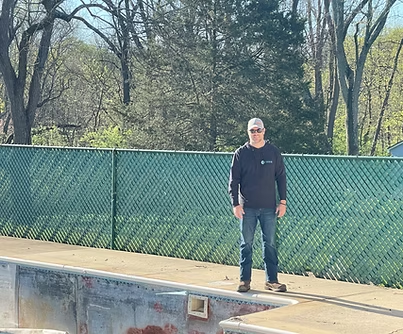
Tim Robinson is the owner of Robinson Landscape LLC, proudly serving Bucks and Montgomery Counties for over 24 years. Known for his strong work ethic, clear communication, and reliability, Tim brings passion and professionalism to every job. When he’s not working, he enjoys time with his wife, two kids, and their family dog.

